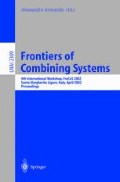Abstract
We consider the language obtained by mixing the model of the regions and the propositional linear temporal logic. In particular, we propose alternative languages where the model of the regions is replaced by different forms of qualitative spatial or temporal reasoning. In these languages, qualitative formulas describe the movement and the relative positions of spatial or temporal entities in some spatial or temporal universe. This paper addresses the issue of the formal proof that for all forms of qualitative spatial and temporal reasoning such that consistent atomic constraint satisfaction problems are globally consistent, determining of any given qualitative formula whether it is satisfiable or not is PSPACE-complete.
Access this chapter
Tax calculation will be finalised at checkout
Purchases are for personal use only
Preview
Unable to display preview. Download preview PDF.
References
Allen, J.: Maintaining knowledge about temporal intervals. Communications of the Association for Computing Machinery 26 (1983) 832–843.
Balbiani, P., Condotta, J.-F.: Spatial reasoning about points in a multidimensional setting. Applied Intelligence, to appear.
Balbiani, P., Condotta, J.-F., Fariñas del Cerro, L.: A model for reasoning about bidimensional temporal relations. In Cohn, A., Schubert, L., Shapiro, S. (Eds.): Proceedings of the Sixth International Conference on Principles of Knowledge Representation and Reasoning. Morgan Kaufmann (1998) 124–130.
Balbiani, P., Osmani, O.: A model for reasoning about topologic relations between cyclic intervals. In Cohn, A., Giunchiglia, F., Selman, B. (Eds.): Proceedings of the Seventh International Conference on Principles of Knowledge Representation and Reasoning. Morgan Kaufmann (2000) 378–385.
Bennett, B.: Determining consistency of topological relations. Constraints 3 (1998)213–225.
Bennett, B., Cohn, A., Wolter, F., Zakharyaschev, M.: Multi-dimensional modal logic as a framework for spatio-temporal reasoning. Applied Intelligence, to appear.
Cristani, M.: The complexity of reasoning about spatial congruence. Journal of Artificial Intelligence Research 11 (1999) 361–390.
Freuder, E.: Synthesizing constraint expressions. Communications of the Association for Computing Machinery 21 (1978) 958–966.
Gerevini, A., Renz, J.: Combining topological and qualitative size constraints for spatial reasoning. In Maher, M., Puget, J.-F. (Eds.): Proceedings of the Fourth International Conference on Principles and Practice of Constraint Programming. Springer-Verlag, Lecture Notes in Computer Science 1520 (1998) 220–234.
Isli, A., Cohn, A.: A new approach to cyclic ordering of 2D orientations using ternary relation algebras. Artificial Intelligence 122 (2000) 137–187.
Ligozat, G.: On generalized interval calculi. In Dean, T., McKeown, K. (Eds.): Proceedings of the Ninth National Conference on Artificial Intelligence AAAI Press (1991) 234–240.
Ligozat, G.: Reasoning about cardinal directions. Journal of Visual Languages and Computing 9 (1998) 23–44.
Moratz, R., Renz, J., Wolter, D.: Qualitative spatial reasoning about line segments. In Horn, W. (Ed.): Proceedings of the Fourteenth European Conference on Artificial Intelligence. Wiley (2000) 234–238.
Nebel, B.: Computational properties of qualitative spatial reasoning: first results. In Wachsmuth, I., Rollinger, C.-R., Brauer, W. (Eds.): Proceedings of the Nineteenth German Conference on Artificial Intelligence. Springer-Verlag, Lecture Notes in Artificial Intelligence 981 (1995) 233–244.
Randell, D., Cui, Z., Cohn, A.: A spatial logic based on regions and connection. In Nebel, B., Rich, C., Swartout, W. (Eds.): Proceedings of the Third International Conference on Principles of Knowledge Representation and Reasoning. Morgan Kaufman (1992) 165–176.
Renz, J., Nebel, B.: On the complexity of qualitative spatial reasoning: a maximal tractable fragment of the region connection calculus. Artificial Intelligence 108 (1999) 69–123.
Savitch, W.: Relationships between nondeterministic and deterministic tape complexities. Journal of Computer and System Sciences 4 (1970) 177–192.
Sistla, A., Clarke, E.: The complexity of propositional linear temporal logics. Journal of the Association for Computing Machinery 32 (1985) 733–749.
Vilain, M., Kautz, H.: Constraint propagation algorithms for temporal reasoning. In Kehler, T., Rosenschein, S., Filman, R., Patel-Schneider, P. (Eds.): Proceedings of the Fifth National Conference on Artificial Intelligence. American Association for Artificial Intelligence (1986) 377–382.
Wolter, F., Zakharyaschev, M.: Spatio-temporal representation and reasoning based on RCC-8. In Cohn, A., Giunchiglia, F., Selman, B. (eds.): Proceedings of the Seventh International Conference on Principles of Knowledge Representation and Reasoning. Morgan Kaufmann (2000) 3–14.
Author information
Authors and Affiliations
Editor information
Editors and Affiliations
Rights and permissions
Copyright information
© 2002 Springer-Verlag Berlin Heidelberg
About this paper
Cite this paper
Balbiani, P., Jean-François, C. (2002). Computational Complexity of Propositional Linear Temporal Logics Based on Qualitative Spatial or Temporal Reasoning. In: Armando, A. (eds) Frontiers of Combining Systems. FroCoS 2002. Lecture Notes in Computer Science(), vol 2309. Springer, Berlin, Heidelberg. https://doi.org/10.1007/3-540-45988-X_13
Download citation
DOI: https://doi.org/10.1007/3-540-45988-X_13
Published:
Publisher Name: Springer, Berlin, Heidelberg
Print ISBN: 978-3-540-43381-1
Online ISBN: 978-3-540-45988-0
eBook Packages: Springer Book Archive

